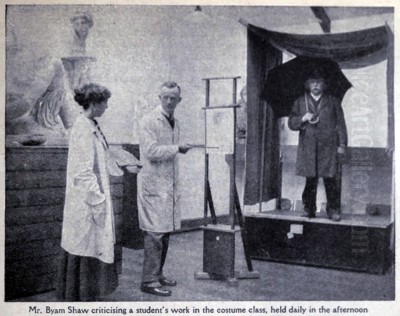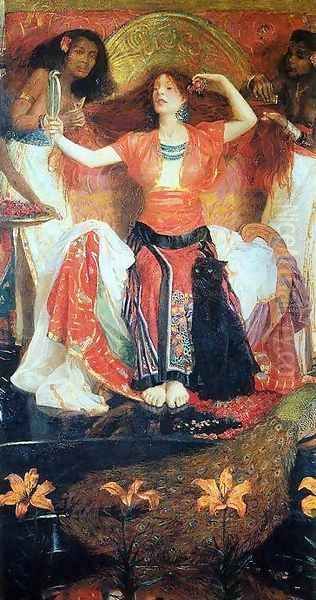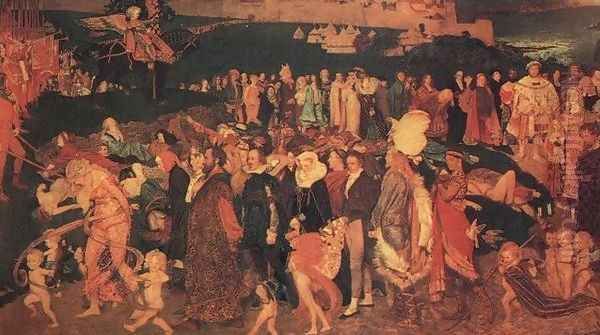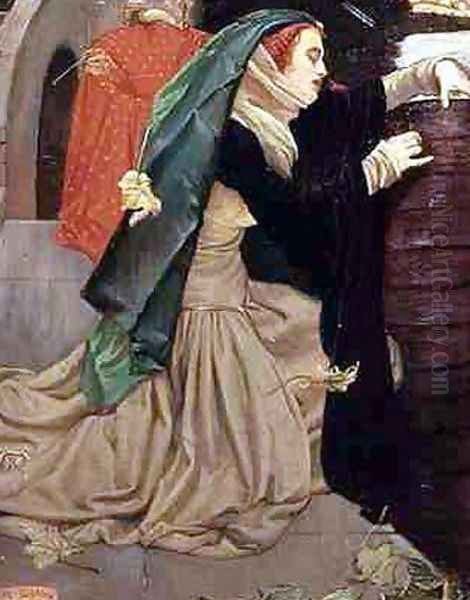
John Byam Liston Shaw, often known simply as Byam Shaw, stands as a significant, if sometimes overlooked, figure in the landscape of late British Romanticism and as a dedicated inheritor of the Pre-Raphaelite tradition. Active during a period of artistic transition at the turn of the 20th century, Shaw carved a niche for himself with his richly detailed, narrative-driven paintings, intricate illustrations, and influential work as an educator. His art, imbued with literary allusions, vibrant colour, and a deep sense of emotional engagement, offers a fascinating window into the artistic currents of his time.
Early Life and Artistic Inclinations
John Byam Liston Shaw was born on November 13, 1872, in Madras, British India. His father, John Shaw, held the position of Registrar of the High Court of Madras, providing a comfortable and educated background for the young Byam. The exotic environment of India, with its vibrant colours and rich cultural tapestry, may have subtly influenced his later artistic sensibilities, particularly his penchant for decorative detail and strong palettes.
In 1878, when Byam was around six years old, the Shaw family relocated to England, settling in Kensington, London. This move placed him at the heart of the British art world. From an early age, Shaw displayed a prodigious talent for drawing. His artistic promise was so evident that by the age of 15, his work caught the discerning eye of Sir John Everett Millais, one of the founding members of the Pre-Raphaelite Brotherhood. Millais, by then a towering figure in British art, recognized the young Shaw's potential and encouraged him to pursue formal art training. This endorsement was a significant boon, paving the way for his entry into dedicated art institutions.
Formal Training and Pre-Raphaelite Immersion
Following Millais's advice, Byam Shaw enrolled at the St John's Wood Art School. This preparatory institution was a common stepping stone for aspiring artists aiming for the prestigious Royal Academy Schools. At St John's Wood, he would have honed his foundational skills in drawing and painting, preparing for the rigorous demands of academic training.

Subsequently, Shaw gained admission to the Royal Academy Schools, the preeminent art institution in Britain. He studied there from 1890, further developing his technical abilities and steeping himself in the academic traditions. However, it was the spirit of the Pre-Raphaelite Brotherhood, which had emerged decades earlier, that truly captured his artistic imagination. Though the original Brotherhood (founded in 1848 by Millais, Dante Gabriel Rossetti, and William Holman Hunt) had largely dissolved, its influence persisted, particularly through the work of second-generation figures like Edward Burne-Jones.
Shaw was deeply drawn to the Pre-Raphaelite emphasis on truth to nature, meticulous detail, luminous colour, and serious, often literary or religious, subject matter. He particularly admired the poetic and romantic qualities found in the works of Dante Gabriel Rossetti. This affinity would become a defining characteristic of his artistic output, positioning him as one of the last notable exponents of the Pre-Raphaelite style in an era increasingly leaning towards modernism. He completed his studies at the Royal Academy Schools around 1892, equipped with a strong technical foundation and a clear artistic vision.
The Pre-Raphaelite Mantle and Artistic Themes
Byam Shaw’s oeuvre is a testament to his deep engagement with Pre-Raphaelite principles. His paintings often feature complex compositions, a jewel-like intensity of colour achieved through careful layering of glazes, and an almost photographic attention to detail in rendering textures, fabrics, and natural elements. He shared the Pre-Raphaelite fascination with medievalism, Arthurian legends, biblical narratives, and the poetry of figures like Keats, Tennyson, and, most significantly for Shaw, Dante Gabriel Rossetti.
His subjects were frequently drawn from literature, mythology, and history, allowing him to explore themes of love, betrayal, heroism, and sacrifice. Works like The Judgment of Solomon (1892), an early success, demonstrate his ability to handle complex biblical narratives with dramatic flair and rich detail. He was not merely illustrating texts but seeking to capture their emotional core and symbolic resonance, much like Rossetti or Burne-Jones had done.
Shaw’s commitment to these ideals placed him somewhat at odds with the emerging avant-garde movements like Impressionism and Post-Impressionism, which were gaining traction in Britain. While artists like Walter Sickert or Philip Wilson Steer were exploring new modes of perception and painterly expression, Shaw remained dedicated to a more narrative and meticulously rendered style. This steadfastness contributed to his reputation as a "latter-day Pre-Raphaelite."
Masterpieces and Notable Works

Throughout his career, Byam Shaw produced a number of paintings that cemented his reputation. One of his most acclaimed and widely recognized works is The Boer War, Last Summer Roses (also known simply as The Boer War), completed in 1901. This painting, inspired by a poem by Dante Gabriel Rossetti, depicts a young woman in mourning, seated in a garden, gazing at a portrait of a soldier, presumably lost in the conflict. The canvas is filled with symbolic details: the fading roses representing lost love and the transience of life, the somber attire, and the poignant expression of grief. It resonated deeply with a public experiencing the anxieties and losses of the ongoing war in South Africa. The work was exhibited at the Royal Academy and later acquired by the Birmingham Museum and Art Gallery.
Another significant early painting is Jezebel (1896). This dramatic portrayal of the biblical queen, moments before her defenestration, showcases Shaw's skill in capturing intense emotion and his flair for historical costume and setting. The rich colours and the dynamic composition contribute to the painting's theatrical power.
His repertoire also included allegorical and symbolic works. The Flag (c. 1915-1918), created during World War I, is a patriotic piece depicting a Canadian soldier standing beside the personification of Britannia, with the British lion at their feet, symbolizing the unity of the Empire. Such works highlight his ability to respond to contemporary events through the lens of his established artistic style. Other notable paintings include Love the Conqueror and The Comforter, which further explore themes of love, spirituality, and human emotion with his characteristic richness.
A Prolific Illustrator and Designer
Beyond his easel paintings, Byam Shaw was a highly accomplished and prolific illustrator. In an era when illustrated books were immensely popular, his talents were in high demand. He brought the same meticulous detail and romantic sensibility to his black-and-white and colour illustrations as he did to his paintings.
His most extensive illustration project was for the 39-volume "Chiswick Shakespeare," published around the turn of the century. For this, he created numerous drawings that captured the drama and poetry of Shakespeare's plays. His illustrations for Boccaccio's Decameron, Edgar Allan Poe's tales, and various children's books and historical romances further demonstrated his versatility. His style was well-suited to the narrative demands of illustration, often incorporating decorative borders and a strong sense of design, showing an affinity with the burgeoning Art Nouveau movement, though his core remained Pre-Raphaelite.
Shaw also undertook decorative commissions, including designs for stained glass and tapestries. This breadth of activity aligns him with the spirit of the Arts and Crafts movement, championed by figures like William Morris, which sought to break down hierarchies between fine and applied arts and to bring beauty into everyday objects.
The Byam Shaw School of Art: A Legacy in Education

A crucial aspect of Byam Shaw's contribution to British art was his role as an educator. In 1910, he co-founded an art school with his friend and fellow artist, Rex Vicat Cole. Initially named the Byam Shaw and Vicat Cole School of Art, it was located in Campden Street, Kensington. After Cole's departure, it became known as the Byam Shaw School of Art.
The school aimed to provide a traditional grounding in drawing and painting, emphasizing the skills and principles that Shaw himself held dear. It offered an alternative to some of the more radical approaches to art education that were beginning to emerge. Shaw served as the principal and a dedicated teacher, imparting his knowledge and passion to a new generation of artists. His teaching philosophy was rooted in the importance of craftsmanship, observation, and an understanding of art history, particularly the Pre-Raphaelite ideals.
The Byam Shaw School of Art gained a strong reputation and continued to operate independently for many decades, nurturing talents such as the war artist Evelyn Dunbar and the painter Winifred Nicholson (though she attended before it was solely the Byam Shaw School). Eventually, in 2003, it merged with Central Saint Martins College of Arts and Design, part of the University of the Arts London, ensuring that Byam Shaw's name and educational legacy continue in a contemporary context.
Artistic Circle, Contemporaries, and Influences
Byam Shaw operated within a vibrant, albeit traditional, segment of the London art world. His early encouragement from Sir John Everett Millais was pivotal. His collaboration with Rex Vicat Cole in founding their art school signifies a close professional and personal bond.
As a late Pre-Raphaelite, he looked to the founding figures: Dante Gabriel Rossetti for his poetic intensity and romantic medievalism, William Holman Hunt for his moral seriousness and meticulous realism, and Millais for his early technical brilliance and narrative power. He also shared affinities with second-generation Pre-Raphaelites like Sir Edward Burne-Jones, whose dreamlike, elongated figures and tapestried compositions resonated with Shaw's own decorative and romantic leanings.
Among his contemporaries, one can draw comparisons with other artists who continued narrative and figurative traditions. J.W. Waterhouse, for instance, painted mythological and literary scenes with a similar romanticism, though often with a softer, more classical touch. Frank Dicksee and Frederic Leighton, though more academic, also specialized in historical and literary subjects rendered with high finish. In the realm of illustration, Shaw's contemporaries included luminaries like Arthur Rackham and Edmund Dulac, who, like Shaw, contributed to the "Golden Age of Illustration," though their styles often veered more towards fantasy and the exotic. Walter Crane was another significant figure in illustration and design, deeply involved in the Arts and Crafts movement. Shaw's work, however, retained a distinct Pre-Raphaelite flavour that set it apart. He was less overtly symbolist than George Frederic Watts, but shared a commitment to art with serious intent.
Exhibitions and Recognition
Byam Shaw regularly exhibited his work at the Royal Academy, the principal venue for established artists in Britain. His paintings were generally well-received by critics who appreciated his technical skill and the sincerity of his vision, even if his style was not at the cutting edge of artistic innovation.
In 1902, he held a significant solo exhibition at Dowdeswell's Galleries in London, titled "Sermons in Stones and Good in Everything," which showcased a collection of his works and helped to solidify his reputation. His paintings were also shown in other important venues, and The Boer War was notably exhibited at the Birmingham City Art Gallery after its acquisition. While he may not have achieved the same level of fame as the original Pre-Raphaelites or some of his more avant-garde contemporaries, he was a respected and recognized figure in the art world of his day.
Later Life, Wartime Service, and Untimely Death
The outbreak of World War I in 1914 profoundly impacted British society, and Byam Shaw, like many of his generation, contributed to the war effort. He and Rex Vicat Cole joined the Artists Rifles, a volunteer regiment. Later, they served in the Special Constabulary. This period likely curtailed some of his artistic production, though he did create patriotic works like The Flag.
Tragically, Byam Shaw's life was cut short. He died relatively young, at the age of 46, on January 26, 1919, in London, a victim of the devastating influenza pandemic that swept the globe following the war. His premature death deprived the British art world of a dedicated artist and teacher who still had much to offer. His family continued his artistic lineage; one of his sons, James Byam Shaw (often confused with his father in later exhibition records due to the shared name, but he was an art historian specializing in Old Master drawings), became a distinguished art historian and collector. Another son, David Byam Shaw, served as a Royal Navy officer and was tragically killed during World War II.
Enduring Legacy
John Byam Liston Shaw's legacy is multifaceted. As a painter, he was one of the last significant standard-bearers of the Pre-Raphaelite tradition, creating works of intricate beauty, narrative depth, and emotional power. His paintings offer a rich tapestry of literary, historical, and allegorical themes, executed with a distinctive combination of meticulous detail and vibrant colour.
As an illustrator, he contributed significantly to the visual culture of his time, bringing classic texts to life for a wide audience. His work in this field demonstrates his versatility and his keen sense of design.
Perhaps his most enduring legacy lies in art education. The Byam Shaw School of Art, which bore his name for nearly a century, played an important role in training generations of artists, upholding principles of craftsmanship and traditional skills. Its eventual incorporation into Central Saint Martins ensures that his name remains associated with excellence in art education.
While the tide of modernism largely overtook the Pre-Raphaelite style in the 20th century, there has been a renewed appreciation for Victorian and Edwardian art in more recent decades. In this context, John Byam Liston Shaw's work is increasingly recognized for its unique qualities and its sincere dedication to a particular artistic vision. He remains a compelling figure for those interested in the rich and diverse currents of British art at the turn of the 20th century. His art serves as a vibrant link to a romantic past, rendered with a skill and passion that continue to captivate.